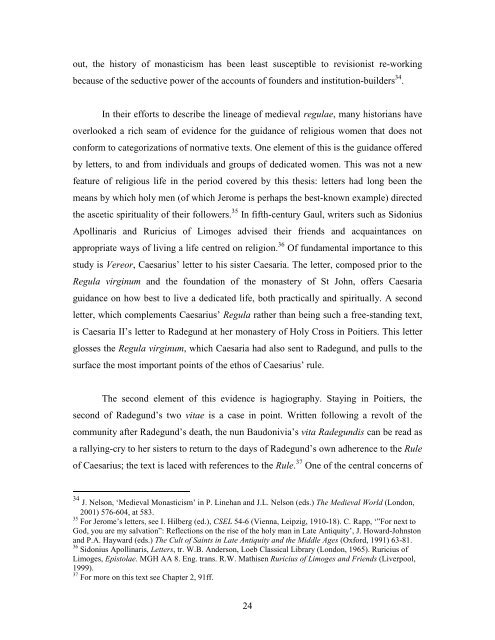Lindsay Rudge PhD Thesis - University of St Andrews
Lindsay Rudge PhD Thesis - University of St Andrews
Lindsay Rudge PhD Thesis - University of St Andrews
Create successful ePaper yourself
Turn your PDF publications into a flip-book with our unique Google optimized e-Paper software.
out, the history <strong>of</strong> monasticism has been least susceptible to revisionist re-working<br />
because <strong>of</strong> the seductive power <strong>of</strong> the accounts <strong>of</strong> founders and institution-builders 34 .<br />
In their efforts to describe the lineage <strong>of</strong> medieval regulae, many historians have<br />
overlooked a rich seam <strong>of</strong> evidence for the guidance <strong>of</strong> religious women that does not<br />
conform to categorizations <strong>of</strong> normative texts. One element <strong>of</strong> this is the guidance <strong>of</strong>fered<br />
by letters, to and from individuals and groups <strong>of</strong> dedicated women. This was not a new<br />
feature <strong>of</strong> religious life in the period covered by this thesis: letters had long been the<br />
means by which holy men (<strong>of</strong> which Jerome is perhaps the best-known example) directed<br />
the ascetic spirituality <strong>of</strong> their followers. 35 In fifth-century Gaul, writers such as Sidonius<br />
Apollinaris and Ruricius <strong>of</strong> Limoges advised their friends and acquaintances on<br />
appropriate ways <strong>of</strong> living a life centred on religion. 36 Of fundamental importance to this<br />
study is Vereor, Caesarius’ letter to his sister Caesaria. The letter, composed prior to the<br />
Regula virginum and the foundation <strong>of</strong> the monastery <strong>of</strong> <strong>St</strong> John, <strong>of</strong>fers Caesaria<br />
guidance on how best to live a dedicated life, both practically and spiritually. A second<br />
letter, which complements Caesarius’ Regula rather than being such a free-standing text,<br />
is Caesaria II’s letter to Radegund at her monastery <strong>of</strong> Holy Cross in Poitiers. This letter<br />
glosses the Regula virginum, which Caesaria had also sent to Radegund, and pulls to the<br />
surface the most important points <strong>of</strong> the ethos <strong>of</strong> Caesarius’ rule.<br />
The second element <strong>of</strong> this evidence is hagiography. <strong>St</strong>aying in Poitiers, the<br />
second <strong>of</strong> Radegund’s two vitae is a case in point. Written following a revolt <strong>of</strong> the<br />
community after Radegund’s death, the nun Baudonivia’s vita Radegundis can be read as<br />
a rallying-cry to her sisters to return to the days <strong>of</strong> Radegund’s own adherence to the Rule<br />
<strong>of</strong> Caesarius; the text is laced with references to the Rule. 37 One <strong>of</strong> the central concerns <strong>of</strong><br />
34<br />
J. Nelson, ‘Medieval Monasticism’ in P. Linehan and J.L. Nelson (eds.) The Medieval World (London,<br />
2001) 576-604, at 583.<br />
35<br />
For Jerome’s letters, see I. Hilberg (ed.), CSEL 54-6 (Vienna, Leipzig, 1910-18). C. Rapp, ‘”For next to<br />
God, you are my salvation”: Reflections on the rise <strong>of</strong> the holy man in Late Antiquity’, J. Howard-Johnston<br />
and P.A. Hayward (eds.) The Cult <strong>of</strong> Saints in Late Antiquity and the Middle Ages (Oxford, 1991) 63-81.<br />
36<br />
Sidonius Apollinaris, Letters, tr. W.B. Anderson, Loeb Classical Library (London, 1965). Ruricius <strong>of</strong><br />
Limoges, Epistolae. MGH AA 8. Eng. trans. R.W. Mathisen Ruricius <strong>of</strong> Limoges and Friends (Liverpool,<br />
1999).<br />
37<br />
For more on this text see Chapter 2, 91ff.<br />
24

















